In new phase of the immunization effort, community groups take a grassroots approach to getting out the vaccine
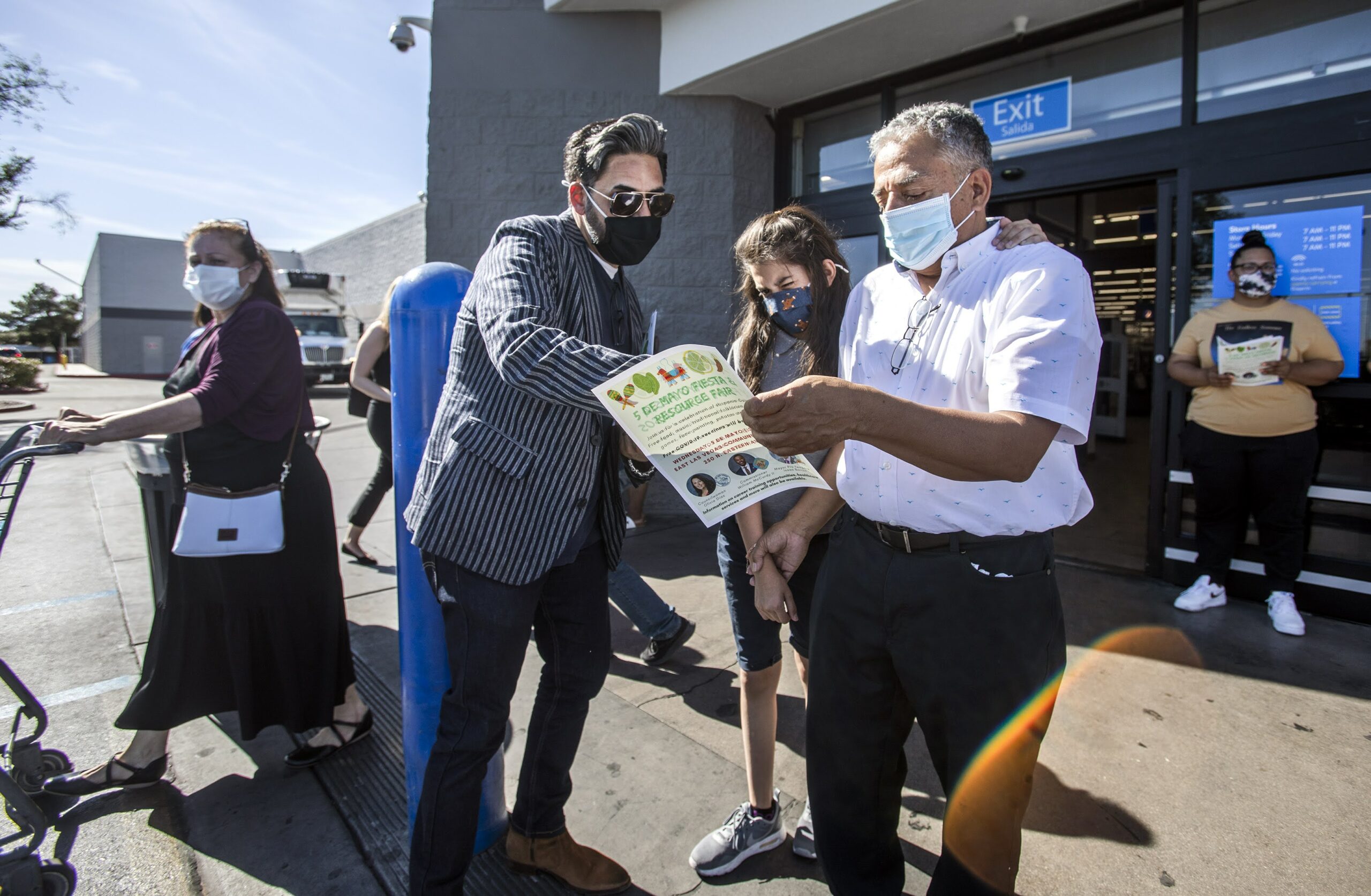
Alice Tu wasn’t opposed to the vaccine, but she had her reservations.
For the last year, Tu has tried to be as careful as possible. As a realtor, she is in frequent contact with the public. When she comes home, she cleans everything and changes her clothes.
But when it came to getting vaccinated, the 41-year-old wasn’t so sure. Every time she’s gotten a flu shot, she’s felt sick within the first week. She and her husband worried about whether any side effects from the vaccine would make it difficult for them to care for their six-year-old. So, they decided to wait.
But, when she saw a post in a Taiwanese Facebook group on Monday morning announcing a no-wait, walk-in vaccine clinic at Shanghai Plaza in Las Vegas, she decided the time had come. She and her husband resolved to make an afternoon of it and grab lunch at the shopping center, which, in addition to the pop-up vaccine clinic, is home to an ever-expanding array of popular Asian eateries.
After five minutes of filling out paperwork in the clinic’s outdoor lobby, Tu was whisked into a check-in office, where she was handed a sticker, pin and grocery store coupon and asked if she could return for her second shot three weeks later. A minute later, she was directed into a second room, where an Albertsons pharmacist told her that she would be receiving the Pfizer vaccine, that a sore arm is a common side effect of the first shot and that she should take Tylenol, Motrin or Aleve for any pain.
A minute and 30 seconds later, she was vaccinated. Arrival to shot took a grand total of seven-and-a-half minutes.
“For the good of humankind,” she wrote on a piece of paper in English explaining why she got vaccinated, before adding the phrase in Chinese below. A staffer added it to the wall of similar messages at the clinic.
Tu’s reasons for getting vaccinated are a little more detailed, though: Her elderly parents, who live in California, are vaccinated, and she wants to spend more time with them. She’ll feel more comfortable while working as a realtor. She also has many friends who are opposed to the vaccine and feels like she needs to do her part.
“If one less person does it, what’s going to happen?” Tu said. “I’m going to do whatever I can.”
A few minutes later, her husband joined her. They had planned to stagger their shots in case they experienced any side effects, but he decided last minute to get the shot, too.
“I was like, I got the next two days off, so, it’s like, I might as well,” Tony Ma, 40, said. “I already know about the risks and all of that stuff and my friends all got vaccinated, too.”
This is how the battle against COVID-19 is won: It is won in the might-as-wells. It is won when people run out of arguments against the vaccine and excuses for why they are putting off getting it. It is won when getting vaccinated is easy, quick, convenient and free. It is won when the vaccine is simply there and so are you, and it becomes a question of why wouldn’t you?
Of course, not everyone feels that way. A February survey from UNR found that 73 percent of Nevadans were likely to receive the COVID-19 vaccine — which means that another 27 percent were less sure about getting it. To date, a little less than half of Nevadans who are eligible for the vaccine have been vaccinated against it.
Meanwhile, the latest vaccine survey from the Kaiser Family Foundation found that of the roughly third of adults nationwide who have not yet been vaccinated, 15 percent are in the wait-and-see group, 6 percent will get vaccinated if required and 13 percent say they definitely won’t get vaccinated.
It’s that wait-and-see group that Nevada is currently targeting in the latest phase of its vaccination effort, which has seen a shift away from mass vaccination sites in favor of smaller, more personal community-based vaccination sites and pop-up clinics. The wait-and-sees might not have driven across town to get a vaccine at Cashman Center, but they might be willing to head down to a nearby church, shopping center or school to get the shot. They might not be sure enough about the vaccine to make an appointment online, but they might pop into a local pharmacy.
It’s all part of an effort to reach people where they are — and one that those who work in the health care space say they would do well to learn from moving forward.
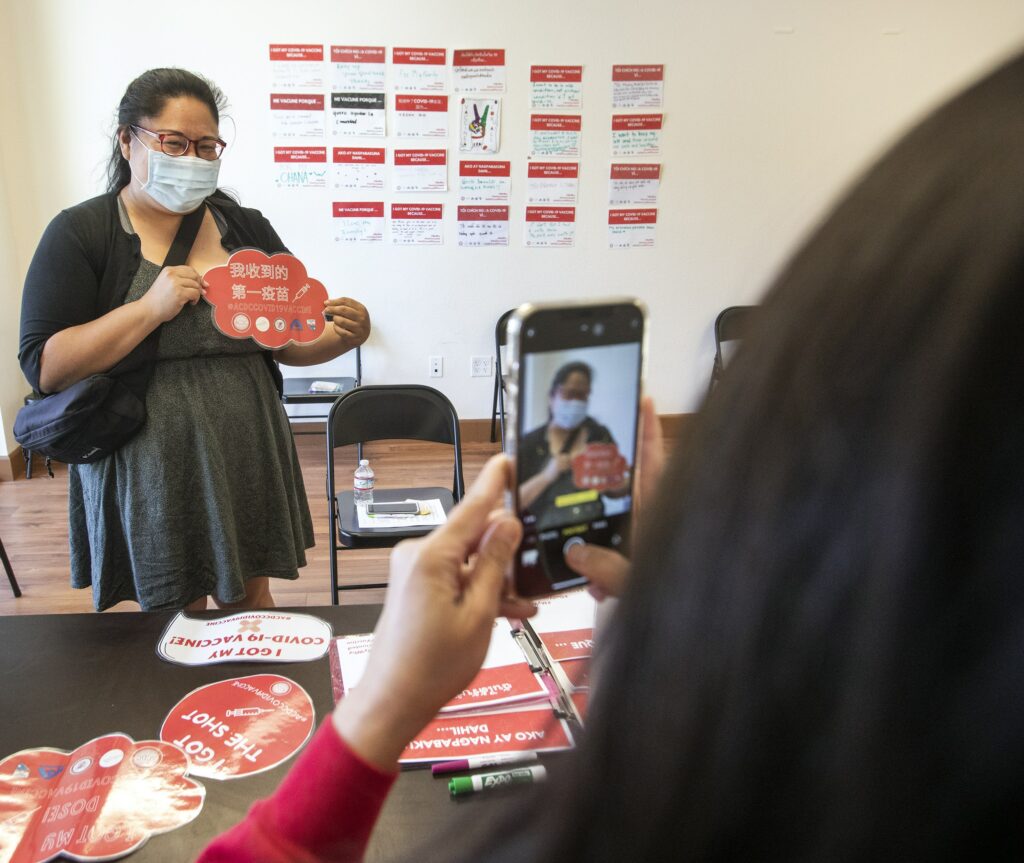
The last day of April felt more like June as the thermometer crept above 100 degrees, yet Wences Perez, dressed in dark jeans and a pinstripe suit jacket, was undeterred as he handed out flyers outside of a Walmart in East Las Vegas.
“Get your COVID vaccine yet?” he asked, one by one in English and Spanish as people streamed into and out of the store late on a Friday afternoon.
Mi Familia Vota, the Latino civic engagement organization, is a common sight outside of grocery stores here. In fact, Cecia Alvarado, the organization's Nevada state director, says people will sometimes call, concerned, when they haven’t seen the organization’s volunteers in a while.
Their usual work consists of citizenship drives, voter registration efforts and get-out-the-vote pushes.
But this spring, they’re getting out the vaccine.
Perez, a volunteer with the organization who also works at the Clark County public defender’s office, had mixed luck on that particular Friday afternoon during an event hosted in partnership with the "Está en Tus Manos" campaign. A lot of people hurriedly told him, yes, they had been vaccinated as they brushed by him. One woman stopped not only to say she had gotten vaccinated but to dig her vaccine card out of her bag and proudly display it to the volunteers, describing it as a “badge of honor.”
Others were less receptive: In the span of 45-minutes, Perez got one “hell no” and a “it’s none of your business.”
But Perez wasn’t there to change minds, necessarily. He was there to inform the not-yets, like the father who stopped to listen to Perez’s pitch and said he wanted to get vaccinated before traveling. When the man came back and said the line for the vaccine was too long inside the Walmart, Perez directed him to a nearby church where he could get vaccinated instead.
Perez was also there to inform the vaccinated, with the hope that they would spread the word about upcoming vaccination opportunities to their friends and family.
“It is a process,” Perez said. “It’s not just about being out here today, it’s about tomorrow, it’s about next week and what we can do to continue to provide resources to our most vulnerable.”
The most vulnerable, in this case, are Nevada’s communities of color, which have not only been hit hardest by COVID-19 but also continue to see some of the lowest rates of vaccination across the state. While Latinos make up 30 percent of the state’s population, they only represent about 23 percent of vaccinated individuals; only 6 percent of vaccinated individuals are Black, compared to 9 percent of the overall population.
Those numbers have improved since February, when Gov. Steve Sisolak first announced the establishment of a task force to ensure that vaccine doses were being equitably administered across the state. But they still show the work left to do in ensuring that in addition to simply being available, vaccines are accessible, convenient and comfortable for communities long mistrustful of the government, the medical community or both.
“A lot of people don't have the time to go stand at Cashman for two hours,” Perez said. “It's important that we bring it to their community, to where they live, to where they shop, to where they do have a few minutes to say, ‘Let me go get that shot.’ It’s important that we make this accessible.”
Over the last year, community organizations, religious groups and others not accustomed to working in the health care space have taken on a public health role. Mi Familia Vota, for instance, is kicking off a 16-week-long door knocking campaign where volunteers will go door to door with iPads helping people make appointments. They’ll also be calling people at home to encourage them to get vaccinated — just as they would ahead of an election to get them to turn out to vote — with the goal of getting as many people vaccinated as possible by the end of the summer.
For some people, Alvarado said, that personal interaction makes the difference.
“We have had people who call us and said they are afraid to get the vaccine because of their immigration status and we’ve gone with them,” Alvarado said. “There was one couple where they were really hesitating about it ... One of our organizers offered to go with them, and he did. It really had an impact not just on them, because they were so happy that they were able to get the vaccine, they were elderly, but they passed on the word to their entire family that it was okay.”


Dream Big Nevada, an immigrant support organization, has similarly been running a peer-to-peer text message and phone banking campaign to get people vaccinated, which have ramped up in recent weeks. Since the beginning of the pandemic, the organization has been answering questions about the vaccine over Facebook Live, helping people make vaccine appointments and helped to launch their own vaccine pop-up site at the office they share with the Immigrant Home Foundation.
“What began as just giving people information, and then making their vaccine appointments, became us hosting our own vaccine site because we saw the cracks that existed and we saw the stuff that needed to be better and we were able to do that,” said Dulce Valencia, the organization’s deputy director.
In Northern Nevada, Washoe County School Board President Angie Taylor has been working with Black faith leaders to boost vaccination rates by hosting education events and clinics either at or close to Black churches.
“We as people of color, and specifically African Americans, are so disproportionately impacted by COVID-19,” Taylor said. “Sometimes people wonder, 'Why do you have to do extra effort?' Because it takes extra effort. If we do traditional things, we’re going to get traditional results, and we’re impacted in a non-traditional way. You have to do things that are targeted so that people who have hesitation or have reservations say, 'Okay this is speaking to me.'”
Though Asian Americans and Pacific Islanders in Nevada have been vaccinated at a slightly higher rate, 11 percent, than the 10 percent of the population they make up, the Asian Community Development Council is focusing on increasing vaccine accessibility within the communities they serve as well. They set up the Shanghai Plaza vaccination site in an effort to better reach families who dine at the shopping center.
“Other places, they get really scared, nobody answers your questions, it’s not that they don’t want to, it’s because they’re afraid to ask,” said Vida Lin, the council’s president.
Vaccine outreach is happening in age-specific ways, too, with young people underrepresented among those vaccinated. Markus Dorsey-Hirt, chief nursing officer for REMSA, the emergency services agency in Washoe County, has been working with UNR to vaccinate fraternity and sorority members. (The Nevada System of Higher Education on Thursday announced that students returning to campus in the fall would be required to be vaccinated.)
“With young people, there is more of a hesitancy because a lot of young people don't think they need to or they’re strong enough and if they get COVID, they get COVID and they’ll recover,” Dorsey-Hirt said. “But that's not always the case.”
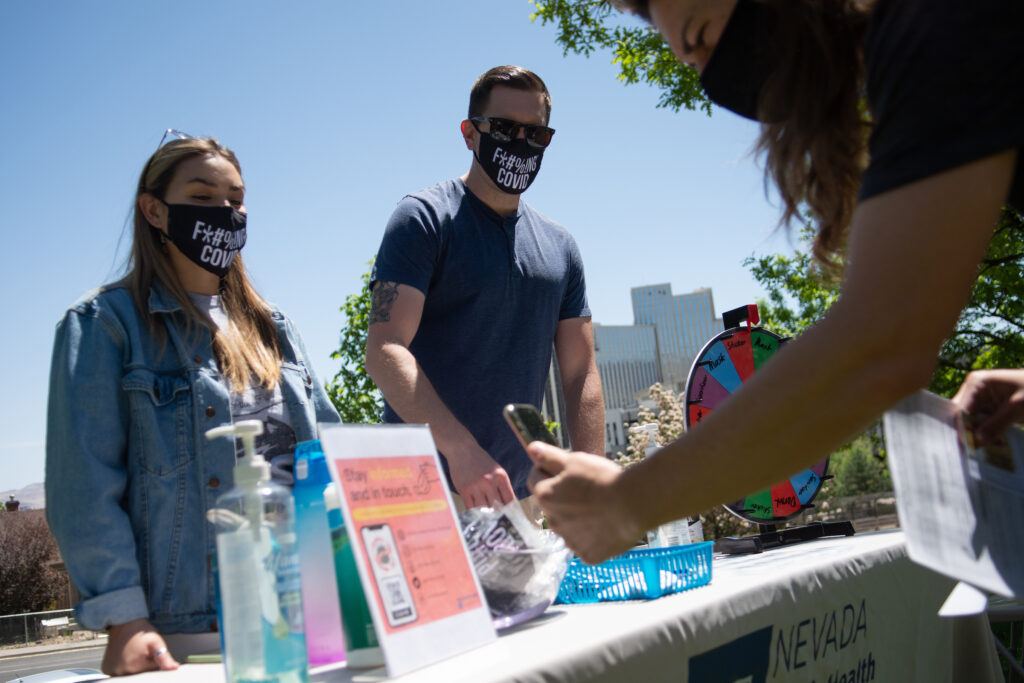

Community groups are continually evaluating what barriers still exist for the communities they’re trying to vaccinate: Are the locations where they’re offering the vaccine are the right ones? Do people still have questions they want answered? Is there a different messaging tactic they should be taking? Will it just take time?
That’s, in part, what Alvarado is hoping to get out of their community outreach efforts in the next few weeks.
“We’re mostly eager to understand better why some of our community members are hesitating to get the vaccine and getting to the root of that so we can help those entities that are in charge of this effort to understand what our community is thinking,” Alvarado said.
There are a few common threads, however, that have already emerged.
A significant challenge that community organizations identified early on was where the vaccine was being offered. In the early days of the vaccination effort, when supply was limited, mass vaccination sites were often the best chance people had at getting vaccinated simply because of the sheer number of people they were able to administer shots to each day.
But for many people, particularly those who are undocumented or live in mixed-status families, the thought of going to a government-run mass vaccination site staffed by fatigue-clad members of the Nevada National Guard was an unpleasant, if not downright scary, one. For others, the thought of going to a big vaccine site and seeing hundreds of people after spending a year mostly isolated was overwhelming, or they couldn’t secure transportation to get there. Others still didn’t have the technological capacity or literacy skills to be able to sign up for an appointment in advance.
“The large centers like Cashman and UNLV were just too intimidating,” said Guy Girardin, president of the Puentes, a nonprofit that connects Latinos with health and social services. “In a lot of these communities that we serve people haven’t had the opportunity to have an education. They were in family situations that required that they left school very early and went to work to support the family. You can’t expect those people to be able to fill out a form, and do those kinds of things, without providing an education.”
Valencia said that she waited in line for three hours at one of the mass vaccination sites in Las Vegas and no one spoke Spanish to her while she was there. She contrasted that against the vaccination site where she worked, where she has personally held people’s hands while they got vaccinated.
“That’s not something that happens at the bigger sites,” Valencia said.
That’s not to say that the larger vaccination sites didn’t serve a critical purpose. On a record day in April, Cashman Center and the Las Vegas Convention Center administered nearly 14,000 vaccines collectively. But, with Cashman Center closing this week, the focus is now shifting to alternative ways of providing the vaccine, whether at new, larger drive-up sites, community-based sites or doctor’s offices and pharmacies.
“Those mass vaccination sites absolutely got us lots of shots in arms quickly, which is what we needed,” said Heidi Parker, executive director of Immunize Nevada. “But we also knew during that time frame that we did need to be able to bring vaccines to the people, to where they are and meet them where they are.”
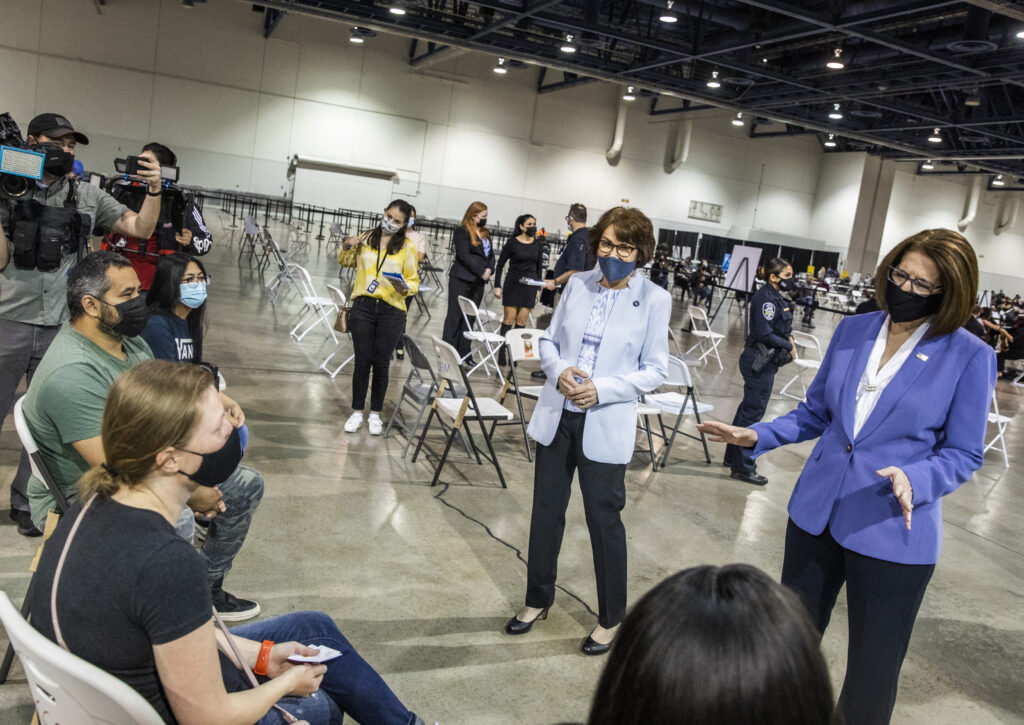
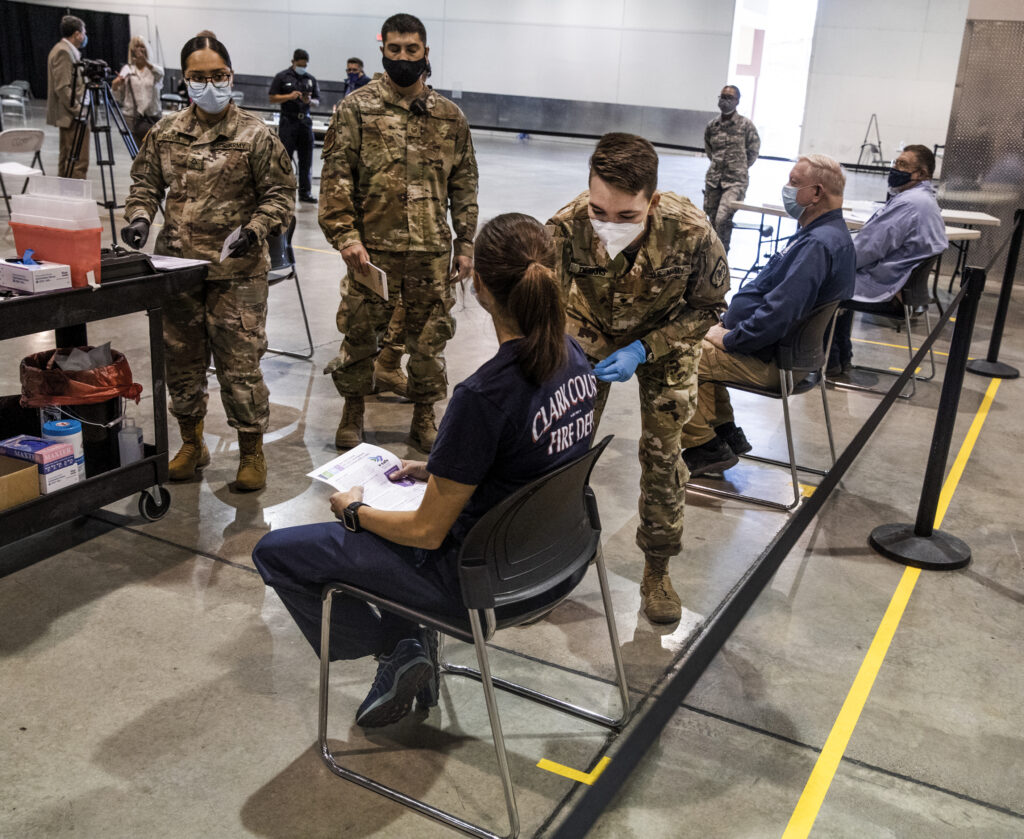
Karissa Loper, who oversees the vaccination effort at the state level, said it’s a transition the state had long expected would occur and was outlined in the state’s vaccination playbook. But it also signifies a shift in the approach the state takes in the vaccination effort from a coordinating to a supporting role, one that mirrors the approach the state is taking when it comes to COVID-19 health and safety measures.
“Pop-up and mobile vaccination clinics are primed for reaching people in their own neighborhoods,” Loper said. “A lot of that coordination is being done by people on the ground so that individuals are hearing from the people that they trust in their own communities.”
There are challenges, though, associated with decentralizing vaccination efforts. Parker said that workforce challenges are key among them.
“They’ve been vaccinating long hours, long days. We’re trying to continue to support them to make sure that we have enough vaccinators that can be deployed now across the community at multiple sites,” Parker said. “We’ve been saying this from the beginning, but this is an all hands on deck approach, and we’re still there.”
But it has been gratifying to those involved in the vaccination effort to see how successful some of the community-based vaccination efforts have been. Parker said that demand at a recent pop-up clinic hosted by Puentes was so great that though they had planned for 300 doses at the site, they had to bring in 200 additional doses midday to keep up.
Puentes has been partnering with Mater Academy, Arriba Las Vegas Workers Center and Immunize Nevada to host more targeted, community-based vaccination events in conjunction with their monthly resource fairs, and they hope to expand their work in the coming weeks by setting up clinics in shopping centers, churches or schools with hours that better meet the needs of the community they serve.
“One of the problems that I think a lot of people are having in the community is that they’re just not able to take time off work to get vaccinated, and there really hasn’t been many opportunities that are late afternoon, early evening,” Girardin said.
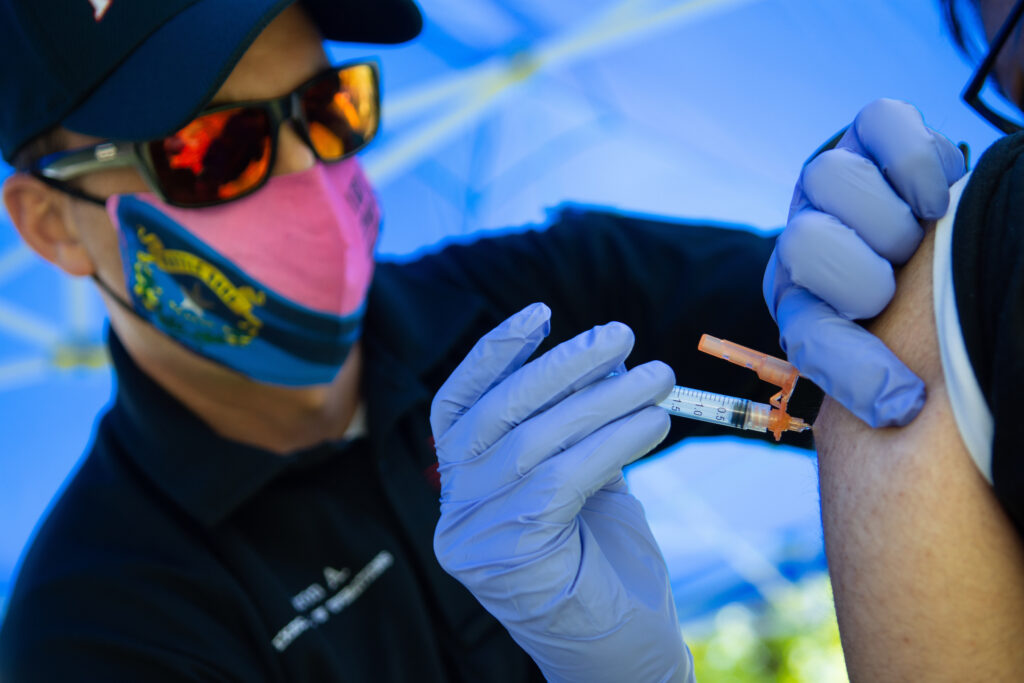
Even the Consulate of Mexico in Las Vegas has gotten involved in the vaccination effort, hosting its own clinics on site. Consul Julián Escutia Rodríguez said that Las Vegas was the first consulate in the U.S. to actually host a vaccination event on site.
“I think that people like to come here. They feel at ease. They feel more trust,” Escutia Rodríguez said. “We are not conducting a massive effort. It’s more symbolic. But I will continue opening the consulate for these events because it’s important.”
As part of the decentralization of the vaccination effort, more doses are also heading to doctor’s offices and pharmacies. As of Wednesday, 275 providers had enrolled with the Nevada State Immunization Program to receive doses of the COVID-19 vaccine, and CVS announced this week that it would now be offering vaccines on a walk-in basis.
While community leaders have praised that move, they also stress the importance of continuing to offer vaccines in other settings, particularly for people who don’t have a primary care provider or don’t feel as comfortable going to a pharmacy.
“Undocumented families are largely uninsured and even mixed-status families are largely uninsured,” said Bliss Requa-Trautz, Arriba’s executive director. “An approach of making the vaccine available at your primary health care provider is not going to be effective for folks who can’t access that.”
Community sites may also be better tailored to meeting people’s individual needs, whether that’s help filling out the paperwork or answering last-minute questions about the vaccine. The organizations that run them have also built trust within the communities that they serve.
“I receive different phone calls to get more collaborations with other agencies within other government areas and counties or and they ask us, ‘How are you making this possible? You are filling your agenda so fast and they're completely successful,’” said Luis Aceves, who works on health care issues within the Latino community through the REACH and Ventanilla de Salud program. “My answer was, ‘We have been working on building trust with our people.’”
For others, though, it’s more than just accessibility: They have real concerns about getting vaccinated.
Jenna Austin, 41, experienced this first hand within her own home. As someone with asthma and other underlying conditions and who travels frequently for work in restaurant food sales, Austin was eager to get vaccinated as soon as possible. Her husband, however, was less thrilled about the prospect.
The public health argument, she said, wasn’t going to work with him. So, instead, she emphasized all of the things that he would be able to do again once vaccinated, including traveling and going to Raiders games. She also noted that even if the government doesn’t put in place vaccine requirements, some businesses may choose to do so on their own to protect themselves and their financial interests.
Those arguments, coupled with the fact that she continued “living and breathing every day” and that Bill Gates was not, in fact, tracking her with a microchip, eventually won him over, she said. But she still had to sign him up for an appointment and, until the day he went, she wasn’t sure he would actually go.
“When he came home with that vaccine, his daughters rallied around him and told him how proud they were of him,” Austin said. “They knew how averse he was to it.”
Earlier this week, Austin said she wasn’t sure that he would make it to his second dose appointment, after how his first dose had gone.
“It was the worst experience ever. She stabbed him. It hurt immediately. He felt lightheaded. He had to have all of the nursing people around him to make sure he was okay because he could immediately feel a rush as soon as it was injected into his arm. His arm is hurting, it’s pulsating, he can’t lift it up, can’t even take a drink with his left hand and lift it to his mouth, it’s that painful,” Austin said. “Tylenol is not helping and ice packs aren’t helping and, ‘this isn’t normal,’ and ‘I told you.’ It was bad.”
But she urged him to just get the second dose so he wouldn’t have to start the process all over again.
On Thursday, she emailed with good news: He had gotten his second shot.
Experiences like this are exactly what community organizations and others involved in the vaccination effort are counting on. They’re hopeful that vaccinated people will return to their families and social circles and share their experiences in the event of persuading more hesitant folks to get vaccinated. For people with reservations about the vaccine, sometimes it helps knowing that someone close to them has gotten vaccinated.
“I definitely have heard a lot from folks that they're waiting for someone else to get the vaccine for them to make sure it's okay,” Requa-Trauz said. “I think we've already seen folks that were initially in that sort of middle ground of waiting for someone else to get it first, they're already coming to the table and getting vaccinated themselves.”
Not everyone, though, has someone at home to have those kinds of conversations with. That’s why community organizations are focusing on education and outreach so that when people finally do have the opportunity to get vaccinated, they get the shot. That can range from answering medical questions to combating misinformation about the vaccine.
“It’s almost like pre-information or pre-education,” Parker said. “We want to make sure that people have the information and any questions answered ahead of being presented with that opportunity.”
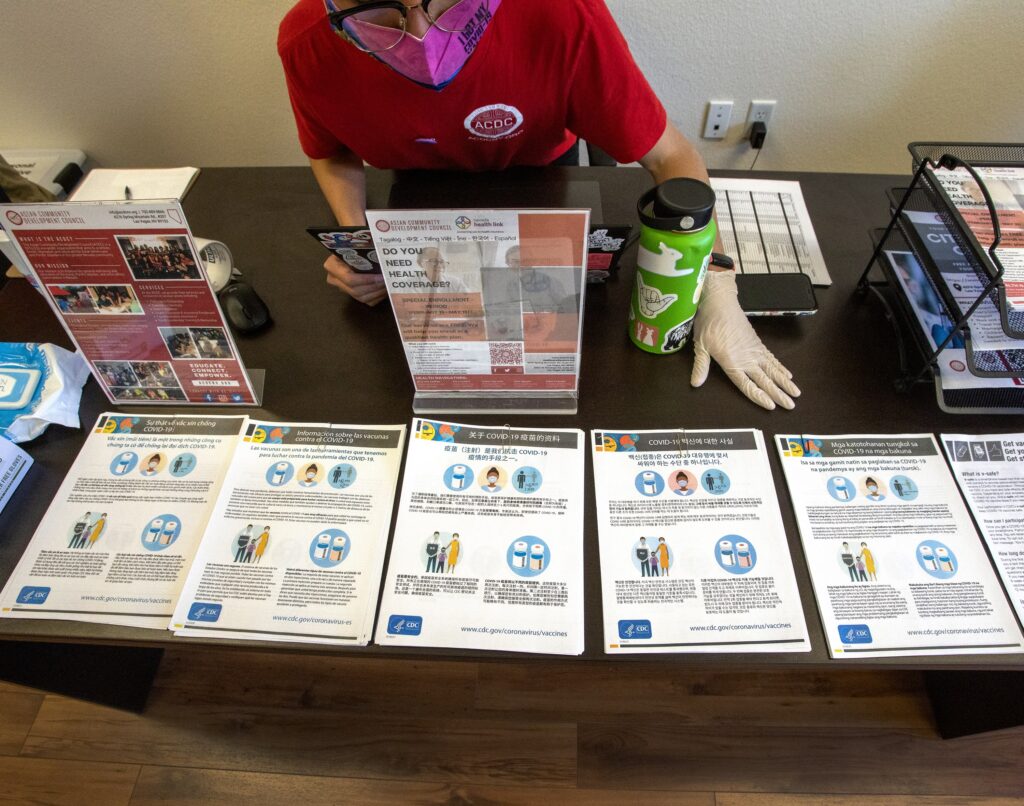
For Dr. Bayo Curry-Winchell, that has meant saying yes to as many opportunities to educate the public about getting vaccinated as possible, with a particular focus on vaccine equity within communities of color. Curry-Winchell is one of only a few Black physicians in Reno.
“The concerns are, ‘Are we going to be guinea pigs? Are we just a test case for the vaccine? Will the vaccine give me COVID-19?” Curry-Winchell said. “Taking the time to acknowledge the past, especially Tuskegee and all of these terrible things that have happened, not just amongst the African-American population but others is important because when you take the time to acknowledge it and learn from it and really help people by saying, ‘Yes, this happened, and this is why this vaccine is different,’ that really opens up the dialogue for new information to be received.”
In addition to answering people’s medical questions, she often shares a personal story with the vaccine, too. Her dad, a 98-year-old World War II, Korean War and Vietnam War veteran, was initially reluctant to get the vaccine. But, after she shared with him her thoughts on the vaccine, he made the decision to get vaccinated. Three weeks later, just before his second dose, he was exposed to COVID-19.
“I do feel that shot protected him, and I know he feels the same way because he shared it with me. He was just elated that he got the vaccine,” Curry-Winchell said. “When it came time for the second shot, he had it on his calendar. He was ready.”
In Northern Nevada, Curry-Winchell participated in an effort not just to educate the Black faith community about the vaccine but Black faith leaders as well, with the hope that they would then return and share their experiences with their congregations.
“There are people who really trust their pastor or their priest more than they trust their doctor or other people,” Curry-Winchell said.
When it came time to host an actual vaccination event — which the Black churches did in conjunction with REMSA at Traner Middle School in Reno as a drive-through style operation in April — they reserved one lane just for questions. Curry-Winchell said that everybody that went through that lane ended up getting vaccinated.
“Even if they wouldn’t have, there still would have been pride in, we at least gave you the information so you can make the best decision for you and your family,” she said. “That has been kind of the key for me, to identify how we can improve upon knowledge in the medical space, access and just the diversity in information.”
For those working with the Latino community, part of the education effort has focused on continuing to emphasize that people can get vaccinated regardless of their immigration status.
“I have been saying, ‘Vaccination has nothing to do with immigration,’ like a mantra, repeating and repeating this,” Escutia Rodríguez said. “I think that that message has really permeated in our community.”
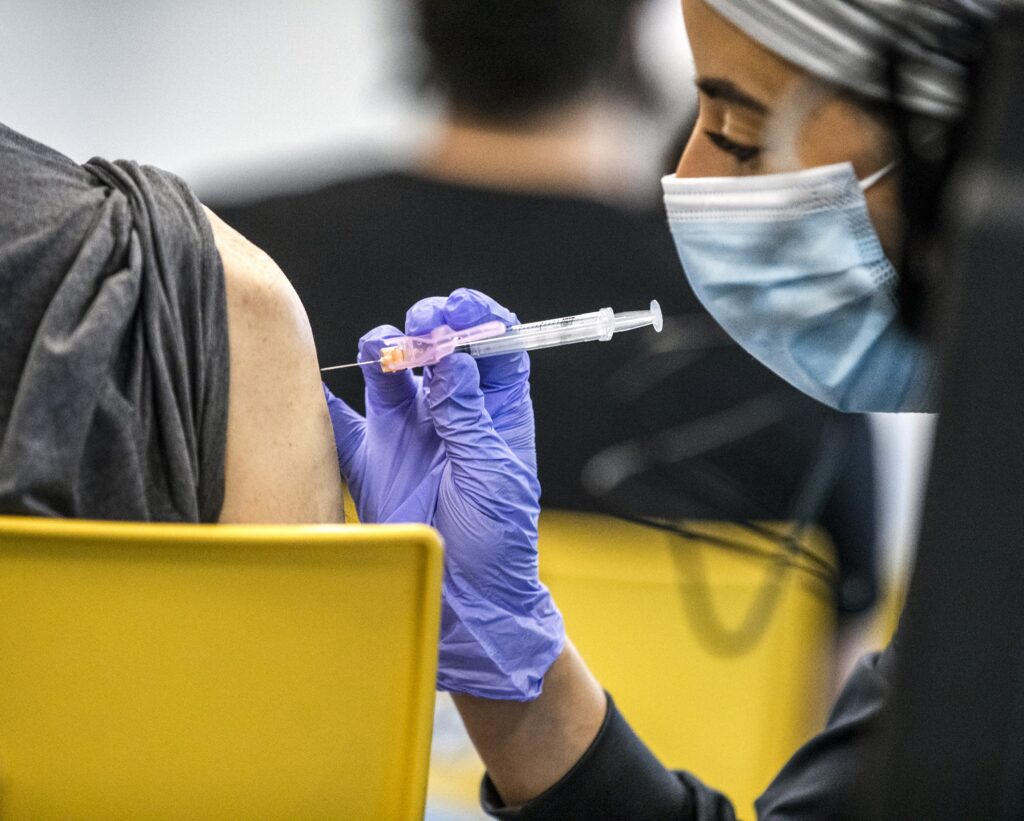
Those involved in the vaccination effort note that the trusted messenger who convinces someone to get vaccinated is going to be different for every person. For some, it might be a doctor or government public health official. For others, it might be a family member, friend, a trusted community organization or a faith leader.
For Nidsa Tarazon, it was the latter. While the 30-year-old paralegal normally would have been eager to get the vaccine, she was reluctant because she is pregnant. She talked to her midwife when she became eligible for the shot in February and decided to delay getting the vaccine.
But when several of her church leaders posted photos on social media sharing that they had been vaccinated and why they made the decision to get the vaccine, Tarazon, who is LDS, reconsidered her decision to wait. After reviewing the preliminary data on pregnant women and the vaccine and talking again with her midwife, she made the decision to get her shot.
“It really made me think, ‘Okay, I really should read all the studies to make sure I’m making the right choice,” Tarazon said.
For those who work in public health, it has been striking to see just how many organizations have gotten involved in the vaccination effort.
It represents the kind of widespread involvement in health that they would like to see even in non-pandemic times.
“Our intent, from the immunization program, is definitely to sustain these relationships and, at the very least, stay communicative with the partners we've made and the new relationships we've built,” Loper said. “Whether we’re in an emergency response or not, all of the partners are important and every voice that lifts up vaccine confidence and helps answer someone’s question and then helps them decide to get their vaccine is really exciting to see.”
For as plodding as the vaccination effort may seem at times, immunization officials note that with 47 percent of eligible Nevadans vaccinated, the state has exceeded its typical annual flu vaccination rate.
“I think it's optimism for COVID-19 vaccine progress, and I also think it's optimism for flu vaccine progress in the future, only because respiratory disease awareness and thoughts of lung health seem to be top of people's minds,” Loper said.
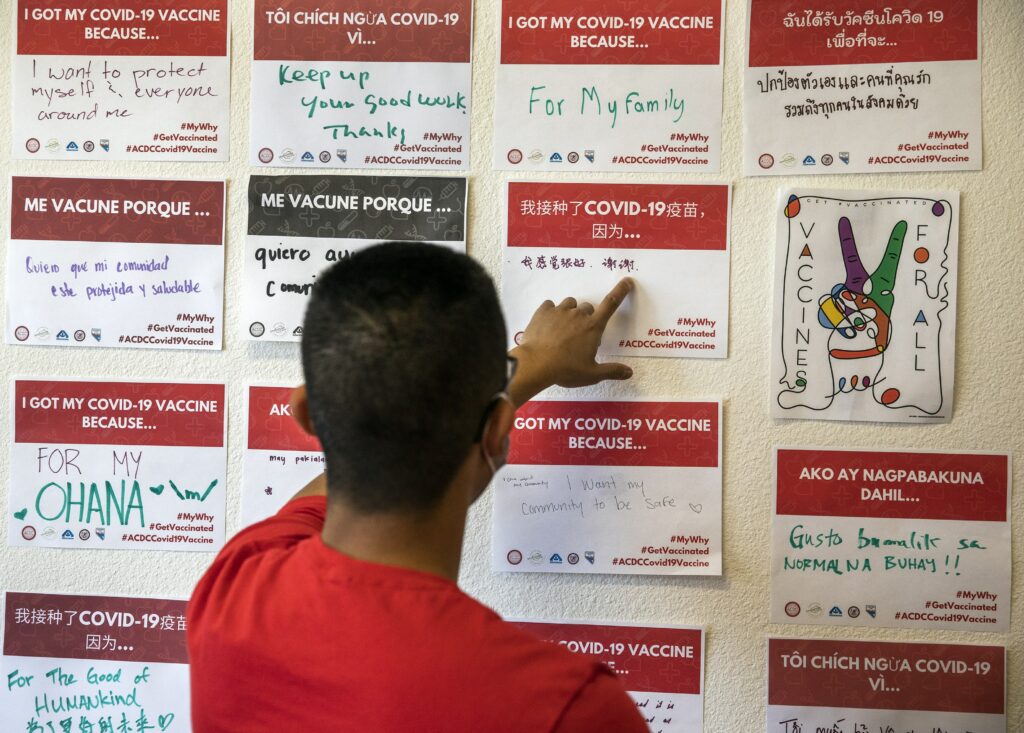
For their part, community organizations say they will remain involved in the vaccination effort for as long they are needed. Many of them got involved in pandemic response efforts simply because they saw a need in their community.
“I'm part of this community. I am an immigrant, I moved to Las Vegas 20 years ago, and I deeply care about my community,” Alvarado, with Mi Familia Vota, said. “That’s why I do this work. I'm going to be there if they need me to help with a vaccine, I'm going to be there to help them register to vote. I’m going to be there if we need to do legislative work. Anything impacts the Latino community, we're going to be there.”
But they’re also counting on vaccinated people to be ambassadors to their own individual pockets of community as well.
For Joshua Pickard, 40, that meant taking the time to calmly and clearly answer his mom’s questions about the vaccine with his girlfriend, a hospital pharmacist, during a Christmas Day phone call. It was a stark departure, he said, from their usual method of yelling at each other until one of them abruptly hangs up.
“She likes arguing. I like to argue, and we end up arguing with each other on just about anything,” Pickard, who works as a butler in Las Vegas, said. “But for this one, when she started asking us questions, we were just trying to give her the best information that we could come up with.”
The phone call, he said, ended with his mom saying that she would think about it and that they had given her a lot of information to consider. A few weeks later, she let him know that she had signed up for her first shot of the vaccine.
He’s still working on his sister, though.
“She’s not certain right now,” Pickard said. “They’re in the camp of, ‘Well, we haven’t had to change anything so far, so what’s the point?’”
